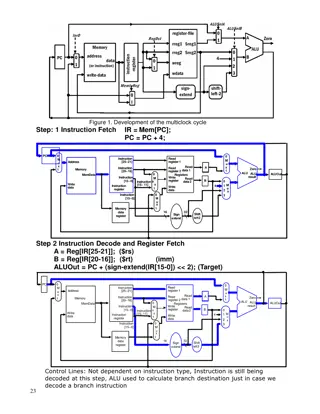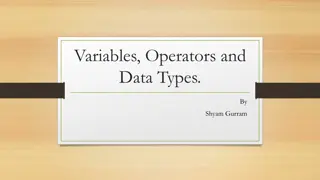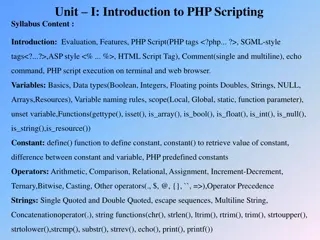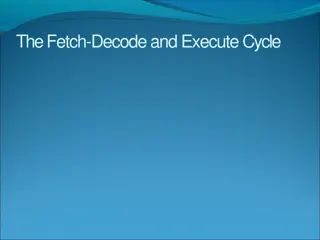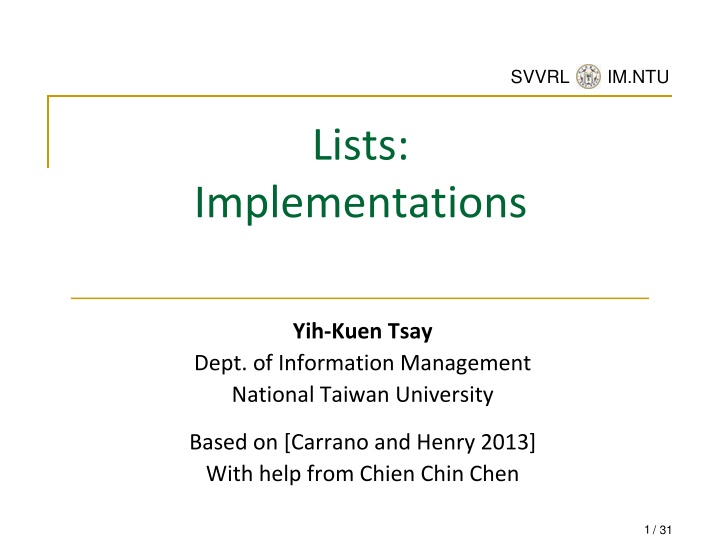
Array-Based List Implementations at National Taiwan University
Explore array-based list implementations at National Taiwan University, following the guidelines from Carrano and Henry (2013). Learn about tasks of ADT implementation, choosing data structures, writing functions, and more in this comprehensive guide with images and code snippets.
Uploaded on | 2 Views
Download Presentation

Please find below an Image/Link to download the presentation.
The content on the website is provided AS IS for your information and personal use only. It may not be sold, licensed, or shared on other websites without obtaining consent from the author. If you encounter any issues during the download, it is possible that the publisher has removed the file from their server.
You are allowed to download the files provided on this website for personal or commercial use, subject to the condition that they are used lawfully. All files are the property of their respective owners.
The content on the website is provided AS IS for your information and personal use only. It may not be sold, licensed, or shared on other websites without obtaining consent from the author.
E N D
Presentation Transcript
SVVRL @ IM.NTU Lists: Implementations Yih-Kuen Tsay Dept. of Information Management National Taiwan University Based on [Carrano and Henry 2013] With help from Chien Chin Chen 1 / 31
SVVRL @ IM.NTU Array-Based Implementation (1/2) Tasks of ADT Implementation: 1. Choose a data structure to represent the ADT s data. 2. Write functions that access the data in accordance with the ADT operation specifications. Array as the data structure for lists: Using an array to represent a list is a natural choice. Both an array and a list identify their items by numbers. However, an array has a fixed size, but a list can have an arbitrary length. You need a variable to keep track of the length of the list. 2 Yih-Kuen Tsay DS 2017: List Implementations / 31
SVVRL @ IM.NTU Array-Based Implementation (2/2) A list s kthitem is stored in items[k-1]. Source: FIGURE 9-1 in [Carrano and Henry 2013]. 3 Yih-Kuen Tsay DS 2017: List Implementations / 31
SVVRL @ IM.NTU An Array-Based List: ArrayList.h (1/2) /** ADT list: Array-based implementation. @file ArrayList.h */ #ifndef _ARRAY_LIST #define _ARRAY_LIST #include "ListInterface.h" #include "PrecondViolatedExcep.h" // See Stacks: Implementations template<class ItemType> class ArrayList: public ListInterface<ItemType> { private: static const int DEFAULT_CAPACITY = 100; ItemType items[DEFAULT_CAPACITY]; // Array of list items int itemCount; // Current count of list items int maxItems; // Maximum capacity of the list 4 Yih-Kuen Tsay DS 2017: List Implementations / 31
SVVRL @ IM.NTU An Array-Based List: ArrayList.h (2/2) public: ArrayList(); // Copy constructor and destructor are supplied by compiler bool isEmpty() const; int getLength() const; bool insert(int newPosition, const ItemType& newEntry); bool remove(int position); void clear(); /** @throw PrecondViolatedExcep if position < 1 or position > getLength(). */ ItemType getEntry(int position) const throw (PrecondViolatedExcep); /** @throw PrecondViolatedExcep if position < 1 or position > getLength(). */ void setEntry (int position, const ItemType & newEntry) throw (PrecondViolatedExcep); }; // end ArrayList #include ArrayList.cpp #endif 5 Yih-Kuen Tsay DS 2017: List Implementations / 31
SVVRL @ IM.NTU An Array-Based List: ArrayList.cpp (1/7) /** @file ArrayList.cpp */ #include ArrayList.h" // header file template<class ItemType> ArrayList<ItemType>::ArrayList(): itemCount(0), maxItems(DEFAULT_CAPACITY) { } // end default constructor template<class ItemType> bool ArrayList<ItemType>::isEmpty() const { return itemCount == 0; } // end isEmpty template<class ItemType> int ArrayList<ItemType>::getLength() const { return itemCount; } // end getLength 6 Yih-Kuen Tsay DS 2017: List Implementations / 31
SVVRL @ IM.NTU An Array-Based List: ArrayList.cpp (2/7) To insert an item, make room in the array. Insertion of item 44 at position 3: k Source: FIGURE 9-2 in [Carrano and Henry 2013]. 7 Yih-Kuen Tsay DS 2017: List Implementations / 31
SVVRL @ IM.NTU An Array-Based List: ArrayList.cpp (3/7) template<class ItemType> bool ArrayList<ItemType>::insert(int newPosition, const ItemType& newEntry) { bool ableToInsert = (newPosition >= 1) && (newPosition <= itemCount + 1) && (itemCount < maxItems); if (ableToInsert) { // Make room for new entry by shifting all items at // positions >= newPosition toward the end of the array // (no shift if newPosition == itemCount + 1) for (int pos = itemCount; pos >= newPosition; pos--) items[pos] = items[pos-1]; // insert newEntry items[newPosition - 1] = newEntry; itemCount++; // Increase count of entries } // end if return ableToInsert; } // end insert 8 Yih-Kuen Tsay DS 2017: List Implementations / 31
SVVRL @ IM.NTU An Array-Based List: ArrayList.cpp (4/7) template<class ItemType> ItemType ArrayList<ItemType>::getEntry(int position) const throw (PrecondViolatedExcep) { // Enforce precondition bool ableToGet = (position >= 1) && (position <= itemCount); if (ableToGet) return items[position - 1]; else { string message = getEntry() called with an empty list or ; message = message + invalid position. ; throw(PrecondViolatedExcep(message)); } // end if } // end getEntry 9 Yih-Kuen Tsay DS 2017: List Implementations / 31
SVVRL @ IM.NTU An Array-Based List: ArrayList.cpp (5/7) template template<class ItemType ArrayList<ItemType>::setEntry(int class ItemType> int position, const const ItemType& newEntry) throw (PrecondViolatedExcep) throw { // Enforce precondition bool bool ableToSet = (position >= 1) && (position <= itemCount); if if (ableToSet) items[position - 1] = newEntry; else else { string string message = setEntry() called with an empty list or ; message = message + invalid position. ; throw throw(PrecondViolatedExcep(message)); } // end if } // end setEntry 10 Yih-Kuen Tsay DS 2017: List Implementations / 31
SVVRL @ IM.NTU An Array-Based List: ArrayList.cpp (6/7) After deleting an item, fill the gap thus caused. Removal of the entry at position 3: Fill the gap caused by the deleted item. k Source: FIGURE 9-3 in [Carrano and Henry 2013]. 11 Yih-Kuen Tsay DS 2017: List Implementations / 31
SVVRL @ IM.NTU An Array-Based List: ArrayList.cpp (7/7) template<class ItemType> bool ArrayList<ItemType>::remove(int position) { bool ableToRemove = (position >= 1) && (position <= itemCount); if (ableToRemove) { // Remove entry by shifting all entries after the one at // position toward the beginning of the array // (no shift if position == itemCount) for (int fromIndex = position, toIndex = fromIndex - 1; fromIndex < itemCount; fromIndex++, toIndex++) items[toIndex] = items[fromIndex]; itemCount--; // Decrease count of entries } // end if return ableToRemove; } // end remove 12 Yih-Kuen Tsay DS 2017: List Implementations / 31
SVVRL @ IM.NTU Link-Based Implementation (1/2) An array has a fixed size. But the ADT list can have an arbitrary length. Using an array, data must be shifted during insertions and deletions. A time-consuming process. A link-based implementation avoids those problems. 13 Yih-Kuen Tsay DS 2017: List Implementations / 31
SVVRL @ IM.NTU Link-Based Implementation (2/2) Representation of the ADT list using pointers Source: FIGURE 9-4 in [Carrano and Henry 2013]. An item in the ADT list is represented as a node in the linked list. Here headPtr points to the first node in the linked list. In addition, the variable itemCount is the current number of entries on the list. 14 Yih-Kuen Tsay DS 2017: List Implementations / 31
SVVRL @ IM.NTU A Link-Based List: LinkedList.h (1/2) /** ADT list: Link-based implementation. @file LinkedList.h */ #ifndef _LINKED_LIST #define _LINKED_LIST #include "ListInterface.h" #include Node.h" #include "PrecondViolatedExcep.h // See Stacks: Implementations // See Link-Based Implementations template<class ItemType> class LinkedList: public ListInterface<ItemType> { private: Node<ItemType>* headPtr; // Pointer to first node in the chain // (contains the first entry in the list) int itemCount; // Current count of list items /** Locates a specified node in a linked list. @ pre position >= 1 and position <= itemCount @ return A pointer to the node at the given position. */ Node<ItemType>* getNodeAt(int position) const; 15 Yih-Kuen Tsay DS 2017: List Implementations / 31
SVVRL @ IM.NTU A Link-Based List: LinkedList.h (2/2) public: LinkedList(); LinkedList(const LinkedList<ItemType>& aList)); virtual ~LinkedList(); bool isEmpty() const; int getLength() const; bool insert(int newPosition, const ItemType& newEntry); bool remove(int position); void clear(); /** @throw PrecondViolatedExcep if position < 1 or position > getLength(). */ ItemType getEntry(int position) const throw (PrecondViolatedExcep); /** @throw PrecondViolatedExcep if position < 1 or position > getLength(). */ void setEntry (int position, const ItemType & newEntry) throw (PrecondViolatedExcep); }; // end LinkedList #include LinkedList.cpp #endif 16 Yih-Kuen Tsay DS 2017: List Implementations / 31
SVVRL @ IM.NTU Constructor and Destructor The default constructor: template<class ItemType> LinkedList<ItemType>::LinkedList(): headPtr(nullptr), itemCount(0) { } // end default constructor A destructor is required for dynamically allocated memory. template<class ItemType> LinkedList<ItemType>::~LinkedList() { clear(); } // end destructor Method clear invokes remove repeatedly until the list is empty, and remove deallocates the nodes it removes. template<class ItemType> void LinkedList<ItemType>::clear() { while (!isEmpty()) remove(1); } // end clear 17 Yih-Kuen Tsay DS 2017: List Implementations / 31
SVVRL @ IM.NTU The getEntry method template<class ItemType> ItemType LinkedList<ItemType>::getEntry(int position) const throw(PrecondViolatedExcep) { // Enforce precondition bool ableToGet = (position >= 1) && (position <= itemCount); if (ableToGet) { Node<ItemType>* nodePtr = getNodeAt(position); return nodePtr->getItem(); } else { string message = getEntry() called with an empty list or ; message = message + invalid position ; throw (PrecondViolatedExcep(message)); } // end if } // end getEntry 18 Yih-Kuen Tsay DS 2017: List Implementations / 31
SVVRL @ IM.NTU The getNodeAt method Locates the node at a given position by traversing the chain. template<class ItemType> Node<ItemType>* LinkedList<ItemType>::getNodeAt(int position) const { // Debugging check of precondition assert( (position >= 1) && (position <= itemCount) ); // Count from the beginning of the chain. Node<ItemType>* curPtr = headPtr; for (int skip = 1; skip < position; skip++) curPtr = curPtr->getNext(); return curPtr; } // end getNodeAt 19 Yih-Kuen Tsay DS 2017: List Implementations / 31
SVVRL @ IM.NTU Overview of Insertion and Deletion Insertion or deletion with pointer modifications. Source: [Carrano 2007]. 20 Yih-Kuen Tsay DS 2017: List Implementations / 31
SVVRL @ IM.NTU Inserting a Node into a Specified Position (1/2) Insert a new node pointed to by newNodePtr between the two nodes that prevPtr and curPtr point to. 1. newNodePtr->setNext(curPtr); 2. prevPtr->setNext(newNodePtr); ... ... 20 40 100 2. 1. 30 prevPtr curPtr Can we reverse the operation sequence ? YES!! newNodePtr 21 Yih-Kuen Tsay DS 2017: List Implementations / 31
SVVRL @ IM.NTU Inserting a Node into a Specified Position (2/2) Inserting at the end of a linked list is not a special case: 1. newNodePtr->setNext(curPtr); 2. prevPtr->setNext(newNodePtr); 2. ... 96 100 1. 102 prevPtr newNodePtr curPtr 22 Yih-Kuen Tsay DS 2017: List Implementations / 31
SVVRL @ IM.NTU Deleting a Specified Node (1/3) Deleting an interior node N: Suppose that node N is pointed to by an external variable curPtr. Variable prevPtr points to the node the precedes N. prevPtr->setNext(curPtr->next); Node N ... ... 5 8 10 100 prevPtr curPtr 23 Yih-Kuen Tsay DS 2017: List Implementations / 31
SVVRL @ IM.NTU Deleting a Specified Node (2/3) Deleting at the end of a linked list is not a special case: prevPtr->setNext(curPtr->getNext()); ... 96 85 100 prevPtr curPtr 24 Yih-Kuen Tsay DS 2017: List Implementations / 31
SVVRL @ IM.NTU Deleting a Specified Node (3/3) Note that node N pointed to by curPtr still exists after its deletion from the linked list. Return deleted node to the system. curPtr->setNext(nullptr); delete curPtr; curPtr = nullptr; Three steps to delete a node: Locate the node that you want to delete. Disconnect this node from the linked list by changing pointers. Return the node to the system. 1. 2. 3. Yih-Kuen Tsay DS 2017: List Implementations 25 / 31
SVVRL @ IM.NTU Using Recursion Let us consider a recursive implementation of the insertion operation. The insert method will need a new private helper function insertNode, which is recursive and takes three arguments: position: the location (relative to the current subchain) to insert newNodePtr: the new node to insert subChainPtr: the head of the current subchain (which is some suffix portion of the original linked list) Yih-Kuen Tsay DS 2017: List Implementations 26 / 31
SVVRL @ IM.NTU Recursively Adding a Node at the Head (1/2) The current list (before the insertion): headPtr 12 3 25 18 After method insert creates a node, before calling insertNode (with headPtr for subChainPtr): newNodePtr 50 As insertNode(1, newNodePtr, headPtr) begins execution: headPtr 12 3 25 18 subChainPtr 27 Yih-Kuen Tsay DS 2017: List Implementations / 31
SVVRL @ IM.NTU Recursively Adding a Node at the Head (2/2) After the new node is linked to the beginning: headPtr 12 3 25 18 subChainPtr 50 After method insert assigns to headPtr the returned reference: headPtr 12 3 25 18 subChainPtr 50 28 Yih-Kuen Tsay DS 2017: List Implementations / 31
SVVRL @ IM.NTU Recursively Adding a Node in the Middle (1/2) As insertNode(3, newNodePtr, headPtr) begins execution: headPtr 12 3 25 18 subChainPtr Recursive call insertNode(2, newNodePtr, subChainPtr- >getNext()): headPtr 12 3 25 18 subChainPtr Recursive call insertNode(1, newNodePtr, subChainPtr- >getNext()): headPtr 12 3 25 18 subChainPtr 29 Yih-Kuen Tsay DS 2017: List Implementations / 31
SVVRL @ IM.NTU Recursively Adding a Node in the Middle (2/2) After a new node is added to the head of subchain: headPtr 12 3 25 18 subChainPtr 50 After the returned pointer is assigned to afterPtr: headPtr 12 3 25 18 subChainPtr 50 afterPtr After subChainPtr->setNext(afterPtr) executes: headPtr 12 3 25 18 subChainPtr 50 30 Yih-Kuen Tsay DS 2017: List Implementations / 31
SVVRL @ IM.NTU Comparison and Summary Reasons for choosing an array-based or a link-based implementation are similar as in the cases of Bags and Stacks. Other differences: An array-based list provides direct access to any of its elements, while a link-based list requires a traversal. Adding an entry to or removing an entry from an array-based list requires shifting of other entries. Inserting an item into a linked list does not shift data, an important advantage over array-based implementations. Adding or removing an entry at or near the end of a link-based list requires a time-consuming traversal. 31 Yih-Kuen Tsay DS 2017: List Implementations / 31







